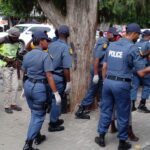What is trafficking in persons?
Trafficking in persons is a global crime trend where children, women and men are taken from their own countries or areas, to a destination country or destination area by force or by being pressurised or tricked into a situation to be exploited.
Who can become a victim of trafficking in persons?
Any person can become a victim – children, adults, males and females.
How are the victims of trafficking in persons, exploited?
Sex trafficking, which includes anything within the sex industry (prostitution, pornography, stripping or exotic dancing, touch-and-peep shows, and escort services) that is forced.
Trafficking for non-commercial sex purposes, which may include early marriage, forced marriage, arranged marriage, compensation marriage, transactional marriage, temporary marriage or marriage for childbearing.
Maternity trafficking, forced impregnation with the intent to exploit or sell the child once he or she is born.
Illegal adoptions with the intent to exploit or sell the child.
Forced labour and child labour, which may include domestic servitude, sweatshops, agricultural labour, construction labour or enforced enrolment in an armed force.
Organ and body part trafficking, which is the forced removal and illegal sale of organs and body parts.
Forced begging and participation in criminal activities.
Why do the victims of trafficking in persons remain in their situation?
Physical entrapment – the victims are physically trapped by restricting their movement, taking their documents and money.
Psychological and emotional entrapment – intimidation through violence and fear; intimidation through shame, threats of arrest, deportation and imprisonment; blackmailing the victim’s family members; starvation, degradation and isolation.
Warning signs of victims of trafficking in persons
Since trafficking in persons is often a crime that is hidden in plain sight, it is important to be aware of its warning signs. Some indications that a person may be a victim of trafficking in person include:.
Appearing malnourished
Showing signs of physical injuries and abuse
Avoiding eye contact, social interaction, and authority figures/law enforcement
Seeming to adhere to scripted or rehearsed responses in social interaction
Seeming to be under the influence of drugs or alcohol with a person appearing to control where they go and which answers for them, not allowing them to speak for themselves
Lacking official identification documents
Appearing destitute/lacking personal possessions
Security measures that appear to keep people inside an establishment – barbed wire inside of a fence, bars covering the insides of windows
Not allowing people to go into public alone, or speak for themselves
Does South Africa have legislation regarding trafficking in persons?
Yes. The Prevention and Combating of Trafficking in Persons Act, 2013 (Act No 7 of 2013) (hereafter referred to as ’the Act’) came into effect on 9 August 2015. The Act makes trafficking in persons, as well as other offences associated with trafficking in persons, criminal offences.












